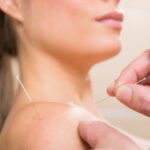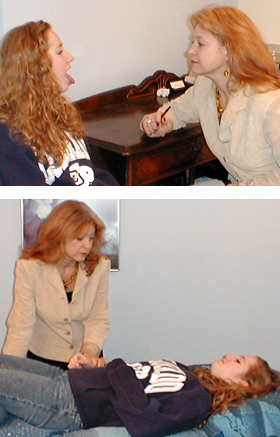Key Facts
- Acupuncture is a type of East Asian medicine that can relieve some types of pain.
- Fine needles (as fine as a piece of hair) are inserted into “acupuncture points” in the skin. Once in place, you shouldn’t feel any discomfort.
- Acupuncture is safe when performed by a licensed acupuncturist.

Acupuncture used to be a treatment that was only practiced in Eastern Asia, but over the years, it has become available in the United States and many other countries. Acupuncture is used to treat conditions such as back pain, headaches, stomach problems, menstrual cramps, and more.
What is acupuncture?
Acupuncture is a type of East Asian Medicine that some people have found helpful to relieve certain kinds of pain and treat certain medical conditions. The name of the professional who does the acupuncture treatments is an “acupuncturist”. During treatment the acupuncturist focuses on the imbalance of three forces, Qi, Yin and Yang, and the Five Elements. Most people who practice East Asian Medicine believe that energy (or Qi) flows through channels in the body called meridians. They believe that certain medical conditions result from a blockage or imbalance in the natural flow of these energy channels, and that acupuncture can help in unblocking the blockage of Qi, and facilitate the Qi flow. Yin and yang, two opposing, but complementary forces, have their balance analyzed. The Five Elements, a third central part of diagnosis, are wood, water, fire, earth, and metal. Each organ (part of the human body) is assigned one of these five elements. The acupuncturist evaluates how these elements and organs interact with one another. All three of these complex ideas are assessed, and acupuncture is then used accordingly to restore balance to the body. Physicians who received special training in acupuncture medicine would provide acupuncture. In addition, licensed acupuncturists are clinicians receive specific instructions and practice in acupuncture studies. After graduating from school, they must pass a national exam to become licensed.
How does acupuncture work?
During an acupuncture treatment, hair-thin fine needles are inserted into “acupuncture points,” which are thought to stimulate the body to release certain chemicals and hormones in the body as well as the nervous systems. This can be useful to ease pain and improve other medical situations.
Although the exact way that acupuncture works is not yet fully understood by scientists, medical studies have shown that acupuncture is safe, and, when combined with other treatments, can be helpful for patients with certain conditions.
What happens when you go to an acupuncturist?

Your first visit with an acupuncturist is similar to the first visit with your health care provider. Your acupuncturist will ask you questions about the reason that brought you in for acupuncture treatments. If you are having pain, he/she will probably ask specific questions such as: Where is the pain? What does it feel like? How often do you have pain? Your acupuncturist will also ask you about other conditions you might have, if you have had any operations and if you are taking any prescription or over-the-counter medications, dietary supplements or herbs.
Two of the ways acupuncturists try to understand what is in balance and what is not is by looking at the color, shape, and coating on your tongue, and by checking your pulse in six different positions. This helps the acupuncturist decide what areas of your body need help and which acupuncture points might be stimulated.
What happens next?
You will probably be asked to change into a gown or roll up your pants/shirt. You may be given a blanket to cover the parts of your body that do not need to be exposed. Next, you will likely be asked to lie down on a soft table so the acupuncturist can place the very fine needles into the acupuncture points on certain areas of your body, such as your belly, legs, hands, etc. Typically, between 5 and 20 needles are used per treatment. Music may be played in the background to help you relax.
What do the needles look like?
Acupuncture needles are very small and thin. If you look at a piece of your hair, that’s just about the thickness of a needle. Only the tip of the acupuncture needle is inserted into the skin. Acupuncture needles are blunt tip and generally you do not see any blood at all.
Where are the needles inserted?
Acupuncture is different from western medicine since acupuncture points represent different places along the “energy channel.” It’s possible that your acupuncturist may decide to place needles in different areas of your body. If you connect the specific acupuncture points together, they would form a meridian. Meridians cover all over the body. The acupuncturist would place acupuncture needles in your legs to help your belly pain.
Do the needles hurt?
Some people become worried when they hear the word “needle”. This is understandable, but the needles that are used for acupuncture don’t look anything like the needles that are used for shots or blood tests. Acupuncture needles are very, very thin and small.
Some people who receive acupuncture feel a little pressure when the needle is inserted, some will feel mild discomfort, and others will feel nothing at all. Once the needles are in the acupuncture points you shouldn’t feel any discomfort. Many people fall asleep during their treatments!
Am I at risk for getting an infection from having acupuncture?
Usually not, because the needles used for acupuncture treatment are sterile. There is, a very low risk of bleeding or bruising where the needles have been inserted, but the risk is much lower than if you were to have a regular type of injection or shot because the needles are much smaller.
What are the pros & cons of acupuncture treatments?
Pros (or benefits) of acupuncture are:
- An acupuncture treatment may provide relief from chronic pain, headaches, or other symptoms
- An acupuncture treatment usually causes no side effects
- You may feel relaxed after an acupuncture treatment
Cons (negative aspects) of acupuncture are:
- Sometimes the symptoms that brought you to the acupuncturist may take few sessions before they start to get better
- You may feel sleepy after a treatment
- As with any medical treatment, not everyone will have improvement in their symptoms after acupuncture
How many treatments will I need to have?
This can vary. The reasons you are having treatments, including whether your problem is acute or chronic, and whether you have more than one condition, will help determine how many treatments might help. Generally acute problems get better after only a couple of treatments, but chronic conditions may require few more visits. Your acupuncture providers will work with you to decide how many treatments would be best for you.
Can I take medicine or have other medical care while I’m having acupuncture treatments?
Yes. It’s important to take any medicine that your health care providers prescribe for you. It is also very important to tell both your health care providers and acupuncturist what medicines you are taking, so they can help you get the most out of the treatments.
Will my insurance cover the acupuncture treatments?
Some insurance companies do cover acupuncture treatments while others do not. The American Academy of Medical Acupuncture is working with insurance companies to try to have acupuncture treatments covered by all insurance companies. For now, it is best to check with your insurance company to find out if all or part of your acupuncture treatment will be covered. If your insurance does not cover acupuncture, you can talk to your acupuncturist about their fees and possible discounts if you are a student. Some college or university health centers provide acupuncture at a reduced cost to students.
Our health guides are developed through a systematic, rigorous process to ensure accuracy, reliability, and trustworthiness. Written and reviewed by experienced healthcare clinicians from Boston Children's Hospital, a Harvard Medical School teaching hospital and consistently ranked as a top hospital by Newsweek and U.S. News & World Report, these guides combine clinical expertise, specialized knowledge, and evidence-based medicine. We also incorporate research and best practices from authoritative sources such as the CDC, NIH, PubMed, top medical journals, and UpToDate.com. Clinical specialists and subject matter experts review and edit each guide, reinforcing our commitment to high-quality, factual, scientifically accurate health information for young people.
